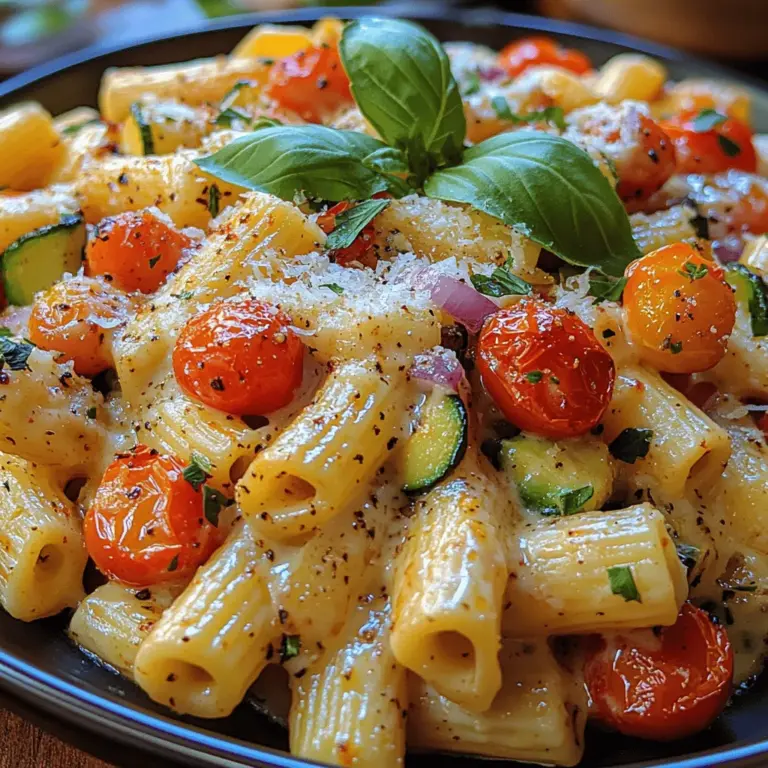Introduction
If you’re in search of a dish that combines comfort, flavor, and nutrition, look no further than creamy roasted veggie pasta. This delectable meal is a delightful blend of al dente pasta enveloped in a rich, creamy sauce, complemented by the natural sweetness of roasted vegetables. The appeal of this dish lies not only in its luxurious texture but also in its ability to transform simple ingredients into a hearty meal that satisfies both the palate and the soul.
Creamy pasta dishes have long been cherished for their comforting qualities. There’s something inherently soothing about a bowl of pasta coated in a luscious sauce, and when paired with vibrant roasted vegetables, it becomes an experience that tantalizes the taste buds and nourishes the body. The incorporation of vegetables into this recipe not only adds a burst of color but also increases the nutritional value, making it a wholesome choice for any meal.
One of the most compelling aspects of creamy roasted veggie pasta is its versatility. Whether you prefer penne or fusilli, want to swap out seasonal vegetables, or adjust the level of creaminess, this recipe is easily adaptable to suit your tastes and dietary needs. Plus, it’s straightforward to prepare, making it an excellent option for busy weeknights or casual gatherings with family and friends.
Understanding the Ingredients
To create a mouthwatering creamy roasted veggie pasta, it’s essential to understand the key ingredients that contribute to its flavor and texture. Each component plays a crucial role in delivering a dish that is both satisfying and healthful.
Essential Ingredients for Creamy Roasted Veggie Pasta
1. Pasta Type: The choice of pasta significantly influences the dish’s overall texture and experience. While penne is known for its tubular shape that holds onto the creamy sauce beautifully, fusilli boasts a spiral shape that adds an element of fun and ensures the sauce clings perfectly. Both options are excellent, allowing you to choose based on personal preference or what you have on hand.
2. Fresh Vegetables: The heart of this recipe lies in the fresh vegetables. Cherry tomatoes, zucchini, bell peppers, and red onions are all excellent choices. Cherry tomatoes provide a natural sweetness that intensifies during roasting, while zucchini adds a tender texture. Bell peppers contribute a crisp bite and vibrant color, and red onions enhance the dish with their mild, slightly sweet flavor. Incorporating a variety of vegetables not only boosts the dish’s nutritional profile but also adds layers of flavor and texture.
3. Garlic: An indispensable ingredient in many recipes, garlic elevates the flavors of the roasted vegetables and the creamy sauce. Its aromatic quality infuses the dish with warmth and depth, making every bite more enjoyable.
4. Olive Oil: This staple offers more than just a cooking medium; it contributes rich flavor and health benefits as well. Olive oil is packed with antioxidants and healthy fats, making it a great choice for roasting vegetables while providing a delightful taste.
5. Seasonings: Simple seasonings like salt, pepper, and Italian herbs (such as oregano and basil) are vital for enhancing the flavors of the vegetables and pasta. They help to create a well-rounded dish that is both savory and aromatic.
6. Dairy Options: The creamy aspect of the pasta can be achieved using heavy cream, which creates a rich and indulgent sauce. Alternatively, for those seeking plant-based options, dairy-free alternatives like coconut milk or cashew cream can provide a luscious creamy texture without the dairy.
7. Cheese: Finally, cheese often plays a starring role in creamy pasta dishes. Grated Parmesan adds a salty, nutty flavor that pairs beautifully with the creamy sauce. For a vegan option, nutritional yeast can be used to impart a cheesy flavor without any animal products.
Preparing the Roasted Vegetables
Roasting vegetables is a simple yet transformative cooking technique that brings out their natural sweetness and flavor. Here’s a step-by-step guide to ensure your vegetables are perfectly roasted:
1. Preheat the Oven: Start by preheating your oven to 425°F (220°C). A hot oven is crucial for achieving that desirable caramelization and ensuring the vegetables are cooked evenly.
2. Cutting the Vegetables: To ensure uniform cooking, cut the vegetables into similar sizes. For cherry tomatoes, you can leave them whole, while zucchini and bell peppers should be sliced into bite-sized pieces. Red onions can be cut into wedges that will hold their shape during roasting.
3. Seasoning and Tossing: In a large mixing bowl, combine the cut vegetables with a generous drizzle of olive oil, salt, pepper, and your choice of Italian herbs. Toss the vegetables well to ensure they are evenly coated with oil and seasoning. This step is crucial for maximizing flavor and achieving a beautifully roasted finish.
4. Roasting Technique: Spread the seasoned vegetables in a single layer on a baking sheet. Avoid overcrowding the pan, as this can lead to steaming rather than roasting. Place the baking sheet in the preheated oven and roast for about 20-25 minutes, or until the vegetables are tender and have developed a golden-brown color. Halfway through the roasting time, give the vegetables a gentle stir to promote even cooking.
5. Achieving Perfect Caramelization: For that coveted caramelized flavor, keep an eye on the vegetables during roasting. If they start to brown too quickly, you can lower the oven temperature slightly. The goal is to have tender, flavorful vegetables with a nice char without burning them.
Cooking the Pasta
Once your vegetables are roasting to perfection, it’s time to prepare the pasta. Properly cooked pasta is essential for creating a harmonious dish. Here are the best practices to achieve the perfect al dente texture:
1. Use Plenty of Salted Water: Fill a large pot with water and add a generous amount of salt. This step is crucial, as it is your only opportunity to season the pasta itself. Aim for about 1-2 tablespoons of salt per gallon of water.
2. Bring to a Boil: Bring the water to a rolling boil before adding the pasta. Adding pasta to water that isn’t boiling can lead to mushy pasta, so patience is key here.
3. Cooking Time: Add the pasta to the boiling water and cook according to the package instructions. For al dente pasta, check a minute or two before the recommended cooking time. You want the pasta to be firm to the bite but not crunchy.
4. Reserve Pasta Water: Before draining the pasta, reserve about a cup of the starchy pasta cooking water. This water can be added to the creamy sauce later to adjust the consistency and enhance the flavor.
By following these steps for both the roasted vegetables and pasta, you’ll set a solid foundation for a delicious creamy roasted veggie pasta that is sure to impress. The combination of roasted vegetables, creamy sauce, and perfectly cooked pasta will create a dish that is not only satisfying but also packed with flavor and nutrition.
{{image_2}}
Creating the Creamy Sauce
Once your roasted vegetables are perfectly caramelized and your pasta is cooked to al dente, it’s time to bring it all together with a luscious creamy sauce that will elevate your Creamy Roasted Veggie Pasta to new heights. The goal here is to create a harmonious blend of flavors and textures that will leave everyone asking for seconds.
Combining Roasted Vegetables and Pasta
Begin by transferring the roasted vegetables from the baking sheet into a large pot or mixing bowl. Gently add the cooked pasta, ensuring that you reserve about a cup of the pasta cooking water for later. The warmth from the roasted vegetables will help to keep the pasta warm, making it easier to combine everything.
When mixing the vegetables and pasta, use a pair of tongs or a large serving spoon to gently fold them together. It’s crucial to be gentle during this process to avoid breaking the pasta. The aim is to create a colorful medley of roasted vegetables and perfectly cooked pasta without compromising the integrity of the noodles.
Techniques for Mixing Vegetables and Pasta Without Breaking the Pasta
To effectively mix the pasta with roasted vegetables without causing breakage, use a folding motion rather than stirring vigorously. This technique will help maintain the structure of the pasta while evenly distributing the vegetables throughout. If you find the mixture a bit dry, don’t hesitate to add a splash of the reserved pasta water. This will help to create a cohesive dish without overpowering the flavors.
How to Achieve the Desired Creaminess with Heavy Cream and Pasta Water
Next, it’s time to introduce the creamy element. Pour in the heavy cream, starting with about half a cup, and mix it gently into the pasta and vegetables. The key to achieving that desired creaminess lies in the balance of heavy cream and the starchy pasta water. The starch from the pasta water will help thicken the sauce and bind it to the pasta without making it too heavy.
As you mix, gradually add more pasta water, a little at a time, until you reach your desired consistency. Aim for a creamy sauce that coats the pasta without being overly runny. Depending on your preference, you might find that you need more or less than the reserved cup of pasta water.
Incorporating Cheese and Ensuring It Melts Evenly for a Creamy Texture
For an added layer of flavor and creaminess, incorporate grated Parmesan cheese into the mixture. Start with about half a cup, and mix it in while the pasta is still warm. This warmth will help the cheese melt evenly, creating a rich, creamy sauce that clings beautifully to the pasta and vegetables. If you’re a cheese lover, feel free to add more cheese to elevate the flavor profile. For an even creamier sauce, consider mixing in a bit of cream cheese or mascarpone cheese, which will contribute to the overall richness.
Final Seasoning and Presentation
Once your creamy sauce is ready, it’s important to fine-tune the flavors. Proper seasoning can make or break your dish, so take a moment to taste and adjust.
Tips for Adjusting Flavors Post-Cooking
Start by adding salt and pepper to taste. A pinch of freshly cracked black pepper can enhance the dish’s flavor profile, while salt brings out the natural sweetness of the roasted vegetables. If you prefer a bit of heat, consider adding a dash of red pepper flakes for a subtle kick. Always taste as you go, adjusting seasonings until you find the perfect balance.
Importance of Tasting and Adjusting Salt and Pepper
Tasting your dish before serving is crucial not only for flavor but also for ensuring that the creamy sauce is well-balanced. Remember that the flavors will continue to develop as they sit, so don’t be afraid to season generously.
Creative Presentation Ideas to Enhance Visual Appeal
Presentation is key to a memorable dining experience. For an eye-catching touch, consider serving your Creamy Roasted Veggie Pasta in a large bowl or individual plates. A sprinkle of additional grated Parmesan on top can create a beautiful contrast against the colorful vegetables.
Importance of Fresh Basil as a Garnish for Flavor and Aesthetics
To elevate your dish further, garnish with freshly chopped basil. Its bright green color and aromatic flavor will not only enhance the dish visually but will also add a fresh element that complements the richness of the cream.
Suggestions for Additional Garnishes, Such as Extra Parmesan and Olive Oil Drizzle
For an extra touch of sophistication, a drizzle of high-quality extra virgin olive oil on top can add richness and a beautiful sheen. You might also consider adding a handful of toasted pine nuts or walnuts for a crunchy texture contrast.
Nutritional Benefits of Creamy Roasted Veggie Pasta
Now that you’ve crafted a beautiful dish, let’s take a moment to explore the nutritional benefits of the primary ingredients in Creamy Roasted Veggie Pasta.
Overview of the Health Benefits of the Primary Ingredients
The combination of roasted vegetables, whole grain pasta, and creamy elements creates a balanced dish that can provide essential nutrients. Roasted vegetables like bell peppers, zucchini, and carrots are rich in vitamins A, C, and K, as well as dietary fiber, which supports digestive health.
Nutritional Value of Vegetables and Their Role in a Balanced Diet
Incorporating a variety of colorful vegetables not only enhances the flavor but also offers a broad spectrum of antioxidants and phytonutrients. These compounds are vital for maintaining a healthy immune system and reducing inflammation.
The Impact of Whole-Grain Pasta on Health
Choosing whole-grain pasta over traditional white pasta adds a significant nutritional boost. Whole grains are higher in fiber, which aids in digestion and promotes a feeling of fullness. They also provide complex carbohydrates that release energy slowly, helping to stabilize blood sugar levels.
Discussing the Balance of Macronutrients in the Dish
This dish strikes a balance between macronutrients, offering carbohydrates from pasta, healthy fats from olive oil and cheese, and protein from the cheese and any additional protein you might choose to include. This balance is essential for a satisfying meal that fuels your body effectively.
Customizing Your Creamy Roasted Veggie Pasta
One of the best aspects of Creamy Roasted Veggie Pasta is its versatility. With a few simple substitutions and additions, you can create a dish that perfectly suits your taste preferences.
Ideas for Ingredient Substitutions and Additions
Feel free to swap out the vegetables based on what you have on hand or what’s in season. Seasonal vegetables not only taste better but also tend to be more nutritious. For example, in the spring, consider adding asparagus and peas, while in the fall, butternut squash and Brussels sprouts would be delightful.
Exploring Other Vegetables to Incorporate Based on Seasonal Availability
Seasonal adjustments can also enhance the flavor profile of your dish. In the summer, zucchini, eggplant, and cherry tomatoes can add a burst of freshness. Winter months might call for root vegetables like sweet potatoes or turnips, which add a hearty quality to the pasta.
Suggestions for Protein Additions, Such as Chicken, Shrimp, or Beans
To turn this dish into a more substantial meal, consider adding protein. Grilled chicken, sautéed shrimp, or even chickpeas can provide an excellent protein boost. For a vegetarian option, you might include lentils or white beans for added texture and nutrition.
Creating a Vegan Version with Plant-Based Substitutes
If you’re looking to make this dish vegan-friendly, simply substitute the heavy cream with a plant-based alternative, such as coconut cream or cashew cream. Nutritional yeast can be used in place of cheese to provide a cheesy flavor without dairy. You can still enjoy the creamy texture and delicious flavors while adhering to a vegan lifestyle.
Conclusion
Creamy Roasted Veggie Pasta is not just a dish; it’s an experience that brings together flavors, colors, and textures in a delightful way. Its versatility allows for endless customization, making it ideal for any occasion—be it a cozy family dinner or an elegant gathering with friends.
Encouraging creativity in the kitchen is part of the joy of cooking. Don’t hesitate to experiment with different vegetables, herbs, and spices to make this dish truly your own. Each time you prepare it, you can create something unique that reflects your tastes and preferences.
Ultimately, there’s immense satisfaction derived from crafting a homemade meal that can be shared and enjoyed with loved ones. So gather your ingredients, unleash your culinary creativity, and indulge in the comforting deliciousness of Creamy Roasted Veggie Pasta.



